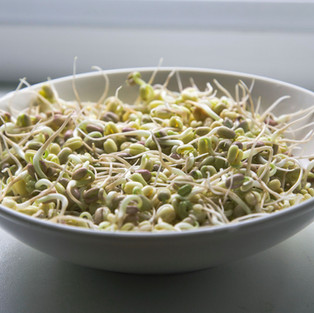What are Antinutrients?
- Vicky Sham

- Oct 15, 2020
- 5 min read
Updated: Oct 16, 2020
Antinutrients are toxins or enzymes inhibitors found in plants that block the digestion or absorption of nutrients in animals and humans. Some taste bitter, some have a soapy texture, others can cause reactions like stomach cramps, bloating, nausea and diarrhea.
Antinutrients protect plants and their seeds from predators, including humans. Since plants don't have arms to fight and legs to run away, antinutrients are plants' defence mechanism to protect their own species and their ability to reproduce.
Plant's Defence Mechanism Grains are seeds of grasses such as wheat, rice, corn, rye, oat, millet and barley. Legumes such as beans, lentils, chickpeas and peanuts are also seeds. Grains and seeds are plants' offspring so it is understandable that they don't want to be eaten by animals and humans. Unlike animals, plants cannot move or run away from predators. In order to protect their offspring (seeds), plants have defence mechanisms such as hard shells, thorns, spines, poison and antinutrients.

For example, cyanide is found in apples, apricots, cherries and peaches. The seeds are poisonous to humans, but you would have to chew large amounts of seeds or pits to be dangerous. Feel safe to continue eating these fruits as long as you do not chew the seeds by the kilos.
Seeds Dispersion
Interestingly, antinutrients enable plants to use birds and animals to spread their seeds across the forest. Some birds do not digest or absorb any nutrient from the seeds they eat. An example is the Southern Cassowaries in Australia, these big birds (60kg) swallow fruits whole and let the poisonous seeds to pass through their digestive system intact. The seeds exit long with their dung and are spread throughout the rainforest, they then proceed to germinate and grow into trees. Some seeds won't even germinate unless they are activated by the fertilisers in the excrements.
Nutritious Grains Traditional diets and cultures have always valued grains and legumes because they are nutritious, rich in fibre, vitamins, and minerals. Plants store up these nutrients to help their seeds germinate and grow into adult plants. Antinutrients help seeds resist digestion or absorption by predators. Can you picture how some seeds can move through our digestive tract and even use our poop as fertiliser?

All Down the Pan
Do you remember having corn on the cob and the kernels passing right through? This is antinutrients at work. Think about how many opportunities that we could have helped these plants spread their seeds and create corn fields, except that we no longer roam the land or forest like our ancestral hunters and gatherers.
Types of Antinutrients
Phytates or phytic acid are found in the outer husks or shells of grains and legumes, as well as nuts and seeds. Phytates bind to minerals like iron, zinc and magnesium and reduce absorption by the body (up to 50% in the case of iron).
Lectins are proteins that bind to carbohydrate and resistant to our digestive system, even acidic conditions of the stomach. They bind to the cells lining the intestinal walls and interfere with absorption of iron, calcium, phosphorus and zinc.
Have you ever had an upset stomach, gas or bloating after eating kidney beans? It was likely caused by a type of lectins called phytohemagglutinin. Fortunately most lectins can be removed after thorough cooking at high temperatures (but not simmering at low temperatures).
Foods high in lectins include soybeans, wheat and nightshades (e.g. tomatoes, eggplants, potatoes).
Saponin are found in oats, quinoa and legumes. They can form a foam when shaken with water. Try rinsing quinoa and you will see some bubbles form. Saponin can bind and prevent absorption of nutrients. Fortunately, you can remove most of the saponin by thoroughly rinsing and cooking quinoa.
Protease inhibitors are found in grains and legumes, especially soybeans. As the name suggests, they inhibit the digestive enzymes protease and making it hard to breakdown protein molecules. These inhibitors can usually be deactivated through soaking, sprouting and boiling.

Oxalates are found commonly in spinach, kale and many dark leafy greens. Oxalate binds to calcium to form salt crystals, making the minerals unavailable for our body to absorb. Oxalate that is not bound to calcium will eventually exit the body through urine. However, if there is too much oxalate and not enough liquid in our body, kidney stones can form as the calcium oxalate crystals accumulate.
One easy way to overcome both problems of calcium absorption and risk of kidney stones is to increase intake of other dietary calcium such as milk, cheese, e.g. creamed spinach, saag paneer. One relatively old study suggests that calcium absorption from milk is not affected by the presence of oxalates. The additional calcium can bind to oxalate in the intestines and prevent it from entering the bloodstream and ending up as crystals in the kidneys.
How to Remove Antinutrients Fortunately, we have always known how to remove antinutrients. For thousands of years, humans have managed to extract nutrients from grains through extensive preparation and traditional cooking.
Traditional Cooking
Traditional preparation and cooking methods are the most effective at removing antinutrients. These include soaking, rinsing, sprouting, boiling, heating and fermenting. Some may require a combination of methods to remove most of the antinutrients.
Have you noticed how traditional cooking of grains and beans always involved soaking (lentils), sprouting (grains), roasting (nuts), high temperature cooking (kidney beans, leafy greens) and fermenting (soy sauce, tempeh, miso). Sprouting nuts and seeds is a smart way to trick the seeds to germinate and release the nutrients, making them more bioavailable for our body.
The slightly unusual one is oxalate. Foods rich in oxalate include spinach, beets, swiss chards, kale and broccoli. Cooking at high temperatures such as boiling, steaming and draining the water can remove most oxalate. Combining with other dietary sources of calcium such as dairy can also improve absorption.
Should We Eat or Avoid Grains? The key is avoid eating large quantities of food containing antinutrients in one sitting and include a variety of foods throughout the day to ensure you get the full spectrum of nutrients. Here is the takeaway:
Avoid refined carbohydrates and processed grains - choose fresh food over packaged food.
If you eat grains, opt for properly prepared whole grains as part of a well-balanced diet.
Say No to Refined Carbs - Choose Fresh Food Over Packaged Food With some attention, most of us can tell the difference between a health food and a hell food. Keep it simple, eat mostly fresh food that is sourced from a plant or an animal (ideally sustainably sourced and humanely raised). Try not to eat any food produced or synthesized in a factory.
From a long term health perspective, almost any fresh food is better than packaged food. Think of one fresh food, that is a single ingredient food, without a label. Then compare it with a packaged food with 10+ ingredients, chemicals, preservatives, and a label that says "high in fibre", 'low-fat", "fortified with…". Which one would you choose for long term health? Hope you find the above useful. If you are interested in getting support to improve your health and wellbeing, I am here to provide some accountability and guidance. Get a free consultation now.
References 1. Schlemmer U, Frølich W, Prieto RM, Grases F. Phytate in foods and significance for humans: food sources, intake, processing, bioavailability, protective role and analysis. Mol Nutr Food Res. 2009 Sep;53 Suppl 2:S330-75.
2. Heaney, R. P., Weaver, C.M. Oxalate: effect on calcium absorbability, American Journal Clinical Nutrition 1989, Oct; 50 (4): 830-2.
3. Chai, W., Leibman, M., Effect of cooking methods on vegetable oxalate content. J Agric Food Chem; 2005, Apr 20: 53 (8): 3027-30
https://pubmed.ncbi.nlm.nih.gov/15826055/
4. 5 Steps for Preventing Kidney Stones
5. Are Antinutrients Harmful?
6. Homo Sapiens: A Brief History of Humankind
by Yuval Noah Harari
7. Undoctored: Why Health Care Has Failed You and How You Can Become Smarter Than Your Doctor
by William Davis, MD
8. Grain Brain
by David Perlmutter, MD
9. Practical Paleo: A Customized Approach to Health and a Whole-Foods Lifestyle
by Diane Sanfilippo, BS, NC




























Comments